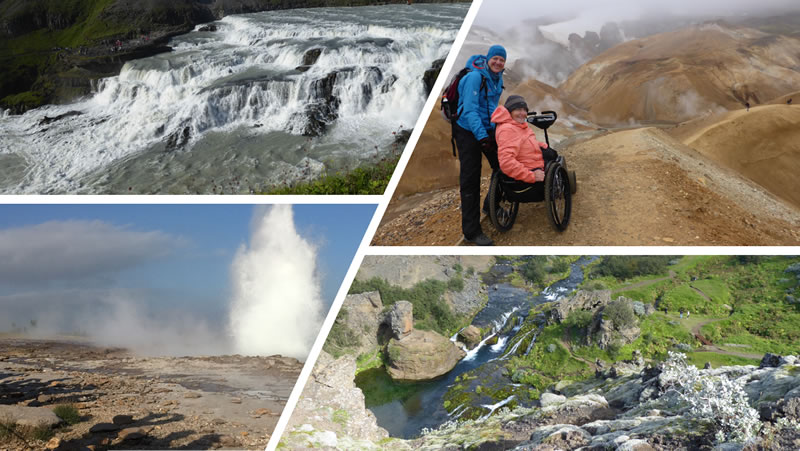Adventure Iceland – an island of fire and ice (part 1)
Gerda Pamler, who has been a partner to Teleflex for many years, explored Iceland in summer as part of a tour of the island in the far north. The following report was kindly put together by her, in which she gives us an insight into various stages of her trip to Iceland. We can anticipate this much: Iceland is a very rewarding, multifaceted, and exciting travel destination.
From Gerda Pamler
9 years ago I was already in Iceland, at that time we circled the whole island. This time we took 3 weeks in August to only stay in the south and inland. The goal was to travel slowly, sometimes to hike, so I had an electric tractor for my wheelchair with me, a so-called Swisstrac. I was able to take this with me on the plane without any problems, checked in as bulky baggage.
Iceland is not barrier-free, although the highlights are definitely accessible and wheelchair-accessible accommodations can also be found. However, the travel agency often did not get a confirmation from the landlord that we got the wheelchair-accessible room. So, it sometimes happened that the barrier-free room was rented to someone else. In Iceland there is a travel agency Unlimited Iceland which also offers trips for people with disabilities, but only for standard trips – however, I wanted to go inland, among other things. The travel agency then completely rejected that for me as a wheelchair user because it is hardly accessible there. And so, we couldn’t book a rental car with hand throttle through the travel agency. So after weeks of research, I put the trip together myself and then booked the hotels, flights and rental cars through a German travel agency Ahorn-Reisen.
The land is rough, the subsoil is mostly coarse rubble and rock. For a trip to Iceland, it is definitely advisable to travel with someone. The varied landscape is characterized by bizarre lava formations, partly covered with green moss, rushing waterfalls, steep cliffs, deep fjords, huge glaciers with lagoons and hot thermal areas. Our first hike was to go to the Reykjadalur valley, translated as the smoking valley. It is famous for its hot river where you can bathe surrounded by breathtaking nature. The hike is rated as easy and research on the internet gave us hope that we could get there with the Swisstrac. Surrounded by steaming springs, it was unfortunately already over after 600 meters, the path was too steep and the ground too rough. The further way even steeper and more narrow. We turned around and looked for another hiking trail, which was unsuccessful. During our search we met a very friendly family who invited us straight away to look around their blooming garden in the middle of the thermal area. The spring behind the house serves as heating and feeds the greenhouse and the pool. A hole in the ground serves as an oven and we could try the homemade bread. This incredible hospitality gave us an interesting insight into Icelandic life and was a great compensation for the escaped hike.
The next stop was at the famous Gullfoss “Golden Waterfall”. The glacier river Hvítá comes from the glacier Langjökull and falls in two stages 31 metres deep into the rugged Gullfossgjúfur canyon at Gullfoss. Geologists believe that this canyon was formed by glacial melting at the beginning of the last ice age. Gullfoss is easily accessible on the official site with the visitor centre, and a wooden plank path gives great insights into the roaring waterfall. But we tried a hike as well from the other side of the river, away from the tourist crowds. Here, too, I had to pass halfway because a fence ladder prevented me from advancing. We found such ladders several times during our trip. Nevertheless, it was a great experience to roll through the lonely vegetation of lichens and herbs on a hiking trail without the crowds.
We drove inland via the highland road Kjölur F35, which is completely closed in winter. The route runs between two glaciers, Langjökull and Hofsjökull, which line the horizon on both sides on the journey. The unpaved slope through extensive gravel and gravel plains is easy to drive on in places, but sometimes only very slowly through deep potholes. Over the Bláfellsháls pass (610m) past the Bláfell tabular volcano, we headed for our destination, the Kerlingarfjöll mountain resort. In Kerlingarfjöll, the Liparit Mountains with their coloured mountains around the geothermal area had already magically attracted me. I really wanted to go there, even if they are not geared towards wheelchair users. The only accommodation was the mountain resort – so it had to work somehow with a wheelchair, we even got a hut with a large bathroom and a ramp. With our 4×4 car we drove five kilometres up the mountain from the mountain resort to the upper parking lot. Here you already have a great view of the Hveradalir thermal area “Valleys of the hot springs”. The slope is sometimes very steep, narrow and filled with many potholes, but it was worth it. An unforgettable sight awaited us. The valley is surrounded by colourful mountain formations made of rust-coloured rhyolite. Around the springs (which unfortunately can only be seen from above in a wheelchair), mineral-rich soils shine in green, red, ochre, blue and form a wonderful contrast to the white of the snowfields that never completely melt away. Kerlingarfjöll was one of the greatest things we have seen in Iceland.
We travelled further north on the Kjölur, to another high temperature area in Hveravellir. Numerous smoking fumaroles and boiling water holes with colourful borders lie along a wooden plank path that is very easy to roll over. A “hotpot” (natural pool) was quickly besieged by the few tourists. It was rather very difficult for me to get in there, so I decided not to. A marked hiking trail of 2.7 km through lava fields, moss and heathland leads to a cave, Eyvindarhóla and Eyvindarrétt, a volcanic rock formation. The Icelander Fjalla Eyvindur, outlawed for theft, hid in the cave with his wife in the 18th century. She has lived in the wilderness of the Icelandic highlands for a total of 20 years. This path was also feasible in a wheelchair with a little help.
In fantastic weather, the highlands showed their most beautiful side on our way back south, with a view of Langjökull. After a break in a small, lonely cafe in Abudir, in a great landscape, we looked for the way to Hvítárvatn. A glacial lake of Langjökull, from which the glacial river Hvíta rises, which then forms the Gullfoss a few kilometres further on. Here you have a great view of the glacier tongue of Norðurjökull which extends to the lake.
TO BE CONTINUED…
Image and text source: Gerda Pamler



